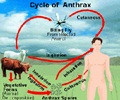- US NIOSH certified N-95, European CE P2, or comparable national/regional standards applicable to the country of manufacture. Higher level particulate respirators may also be used.
- In the control of the outbreak of avian influenza in the Netherlands in 2003, N95 or equivalent respiratory protection was used.
- For treatment, oseltamivir phosphate (Tamiflu®): 75 mg capsule twice daily, for 5 days.
- All concerned (persons at risk both environmentally and occupationally) should be vaccinated with the current WHO recommended influenza vaccine as soon as possible prior to anticipated risk exposure (2 weeks are required to develop preventive immunity by vaccination.). This does not specifically protect against H5N1.
About
Bird flu (avian influenza/avian flu) is a disease caused by an Influenza Virus (H5N1) that primarily affects birds.
Bird flu is a fatal disease of chickens, turkeys, guinea fowls, and other avian species, especially migratory waterfowl. This virus that causes the bird infection can mutate to infect humans.
It is a contagious disease and spreads from person to person through respiratory droplets while coughing and sneezing. The flu is different from a cold and the symptoms can vary from a mild disease with little or no mortality to a highly fatal, rapidly spreading epidemic depending on the infecting virus strain, host factors and environmental stressors.
Anyone including healthy people can contact avian flu, and serious problems from influenza may appear at any age. People at risk for developing bird flu are -
- Farmers and other poultry workers
- Travelers visiting affected countries
- Those who eat raw or undercooked poultry meat, eggs, or blood from infected birds
Fever, headache, body ache, sore throat, nasal congestion and dry cough are some of the symptoms of bird flu. Treatment of bird flu involves isolation of the patient and taking the antiviral medication, oseltamivir.












